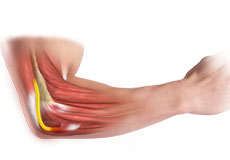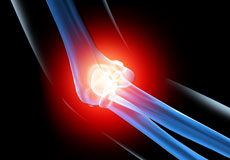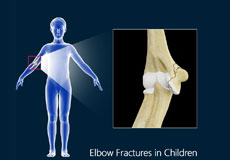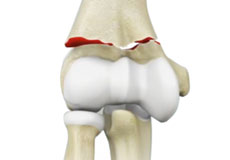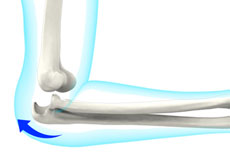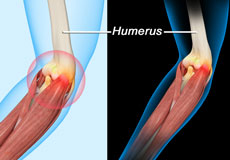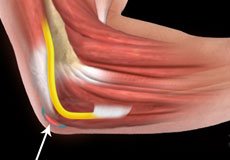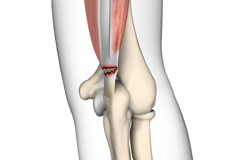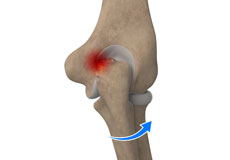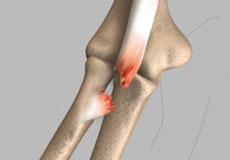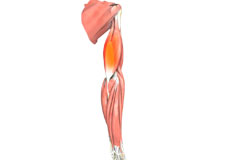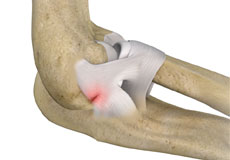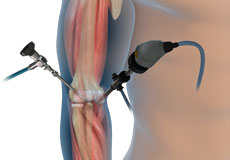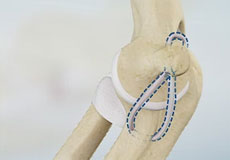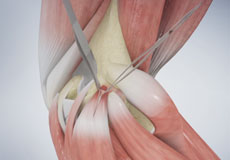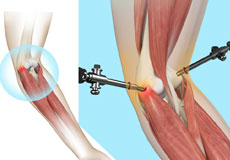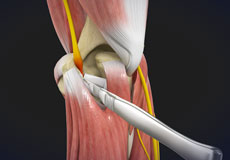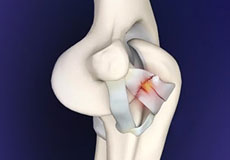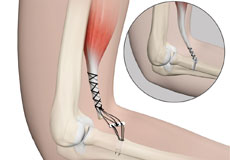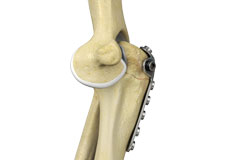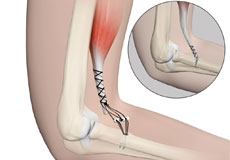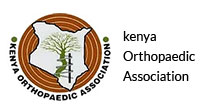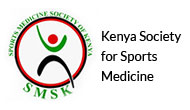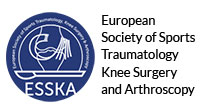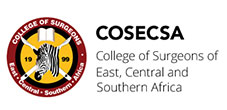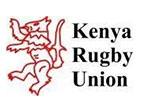Tennis Elbow
Tennis elbow is a common name for the elbow condition lateral epicondylitis. It is an overuse injury that causes inflammation and microtears of the tendons that attach to the lateral epicondyle.
Golfer's Elbow
Golfer’s elbow, also called medial epicondylitis, is a painful condition occurring from repeated muscle contractions in the forearm that leads to inflammation and microtears in the tendons that attach to the medial epicondyle.
Cubital Tunnel Syndrome (Ulnar Nerve Entrapment)
When the elbow is bent, the ulnar nerve can stretch and catch on the bony bump. When the ulnar nerve is compressed or entrapped, the nerve can tear and become inflamed, leading to cubital tunnel syndrome.
Elbow Injuries
The elbow is a complex joint formed by the articulation of three bones – the humerus, radius, and ulna. Articular cartilage lines the articulating regions of the humerus, radius, and ulna. It is a thin, tough, flexible and slippery surface that acts as a shock absorber and cushion to reduce friction between the bones.
Throwing Injuries
An athlete uses an overhand throw to achieve greater speed and distance. Repeated throwing in sports such as baseball and basketball can place a lot of stress on the joints of the arm, and lead to weakening and ultimately, injury to the structures in the elbow.
Elbow Fractures
Elbow fractures may occur from trauma, resulting from various reasons: a fall on an outstretched arm, a direct blow to the elbow or an abnormal twist to the joint beyond its functional limit.
Elbow Pain
Damage to any of the structures that make up the elbow joint can cause elbow pain.
Elbow Trauma
The common symptoms of injury to the elbow joint and its surrounding structures include swelling and pain, which may extend from the elbow to the forearm and palm and be aggravated by movements of the wrist. Sometimes, instability of the joint may also be seen.
Elbow Dislocation
The arm in the human body is made up of three bones that join to form a hinge joint called the elbow. The upper arm bone or humerus connects from the shoulder to the elbow to form the top of the hinge joint. The lower arm or forearm consists of two bones, the radius, and the ulna.
Elbow Sprain
An elbow sprain is an injury to the soft tissues of the elbow. It is caused due to stretching or tearing (partial or full) of the ligaments that support the elbow joint.
Elbow (Olecranon) Bursitis
The elbow contains a large, curved, pointy bone at the back called the olecranon, which is covered by the olecranon bursa, a small fluid-filled sac that allows smooth movement between the bone and overlying skin.
Triceps Injuries
The triceps or triceps brachii is a crucial muscle of the upper arm (humerus). It runs along the upper arm bone between the shoulder and elbow. The triceps tendons connect the triceps muscles to the shoulder blade and elbow in your arm. Tendons are strong bands of tissue that attach muscle to bone.
Elbow Impingement
Elbow impingement is a medical condition characterized by compression and injury of soft tissue structures, such as cartilage, at the back of the elbow or within the elbow joint. It is a condition caused by repetitive forced extensions and overuse of the elbow.
Bicep Tendon Tear at the Elbow
A biceps tear can be complete or partial. Partial biceps tendon tears will not completely break the tendon while complete tendon tears will break the tendon into two parts. Tears of the distal biceps tendon are usually complete and the muscle is separated from the bone.
Triceps Tendonitis
Triceps tendonitis is inflammation of the triceps tendon, the tissue that connects the triceps muscle on the back of the upper arm to the back of the elbow joint, allowing you to straighten your arm back after you have bent it.
Lateral Ulnar Collateral Ligament Injuries (Elbow)
A ligament is a band of elastic, tough fibrous connective tissue around a joint. It attaches bone to bone, supports and holds them together and limits the joint's movement.
Elbow Arthroscopy
Elbow arthroscopy, also referred to as keyhole or minimally invasive surgery, is a surgical procedure that is performed through tiny incisions to evaluate and treat several elbow conditions.
UCL Reconstruction (Tommy John Surgery)
Commonly called Tommy John surgery, this procedure involves reconstructing a damaged ligament on the inside of the elbow called the ulnar or medial collateral ligament with a tendon graft from your own body or a donor.
Golfer's Elbow Surgery
Golfer’s elbow is a condition associated with pain on the inside of the elbow where tendons of your forearm attach to the bony prominence (medial epicondyle). It is also called medial epicondylitis and is caused by injury or irritation to the tendons which can become painful and swollen.
Tennis Elbow Surgery
Tennis elbow is a common name for the elbow condition lateral epicondylitis. It is an overuse injury that causes inflammation and microtears of the tendons that attach to the lateral epicondyle.
Cubital Tunnel Release (Medial Epicondylectomy)
Cubital tunnel release is a surgical procedure to correct cubital tunnel syndrome.
Cubital tunnel syndrome is a condition characterized by compression of the ulnar nerve in an area of the elbow called the cubital tunnel.
Elbow Ligament Reconstruction
Ligament reconstruction is considered in patients with ligament rupture. Your surgeon will make an incision over the elbow. Care is taken to move muscles, tendons, and nerves out of the way. The donor's tendon is harvested from either the forearm or below the knee. Your surgeon drills holes into the bones of the upper arm and forearm, around the elbow joint.
Elbow Tendon and Ligament Repair
Ligament reconstruction is considered to treat ligament rupture. Your surgeon will make an incision over the elbow. Care is taken to move muscles, tendons, and nerves out of the way. The donor's tendon is harvested from either the forearm or below the knee.
Elbow Fracture Reconstruction
Elbow fracture reconstruction is a surgical procedure employed to repair and restore the appearance and full function of a damaged elbow caused by severe trauma or injury. This may include repairing damaged structures or replacing missing or damaged structures with adjoining skin, muscles, ligaments, tendons, bones, or nerves to restore the appearance and function.
Distal Biceps Repair
The biceps is a large muscle located in the front of your upper arm and runs from the shoulder to the elbow joint. It is attached to the bones of the shoulder and elbow by tendons. The distal biceps is the area where the biceps is attached to the forearm bone in the elbow.
The elbow is a complex joint formed by the articulation of three bones – the humerus, radius, and ulna. The elbow joint helps in bending or straightening of the arm to 180 degrees and lifting or moving objects.
The bones of the elbow are supported by:
- Ligaments and tendons
- Muscles
- Nerves
- Blood vessels
Bones and Joints of the Elbow
The elbow joint is formed at the junction of three bones:
- The humerus (upper arm bone) forms the upper portion of the joint. The lower end of the humerus divides into two bony protrusions known as the medial and lateral epicondyles, which can be felt on either side of the elbow joint.
- The ulna is the larger bone of the forearm located on the inner surface of the joint. It articulates with the humerus.
- The radius is the smaller bone of the forearm situated on the outer surface of the joint. The head of the radius is circular and hollow, which allows movement with the humerus. The articulation between the ulna and radius helps the forearm to rotate.
The elbow consists of three joints, namely:
- The humeroulnar joint is formed between the humerus and ulna and allows flexion and extension of the arm.
- The humeroradial joint is formed between the radius and humerus and allows movements like flexion, extension, supination, and pronation.
- The radioulnar joint is formed between the ulna and radius bones and allows rotation of the lower arm.
Articular cartilage lines the articulating regions of the humerus, radius, and ulna. It is a thin, tough, flexible and slippery surface that acts as a shock absorber and cushion to reduce friction between the bones. The cartilage is lubricated with synovial fluid, which further enables the smooth movement of the bones.
Muscles of the Elbow Joint
There are several muscles extending across the elbow joint that help in various movements. These include the following:
- Biceps brachii: Upper arm muscle, enabling flexion of the arm
- Triceps brachii: Muscle in the back of the upper arm that extends the arm and fixes the elbow during fine movements
- Brachialis: Upper arm muscle beneath the biceps, which flexes the elbow towards the body
- Brachioradialis: Forearm muscle that flexes, straightens and pulls the arm at the elbow
- Pronator teres: Muscle that extends from the humeral head, across the elbow, and towards the ulna, and helps to turn the palm facing backwards
- Extensor carpi radialis brevis: Forearm muscle that helps in movement of the hand
- Extensor digitorum: Forearm muscle that helps in movement of the fingers
Ligaments and Tendons of the Elbow
The elbow joint is supported by ligaments and tendons, which provide stability to the joint.
Ligaments are a group of firm tissues that connect bones to other bones. The most important ligaments of the elbow joint are the:
- Medial or ulnar collateral ligament: Comprised of triangular bands of tissue on the inner side of the elbow joint
- Lateral or radial collateral ligament: A thin band of tissue on the outer side of the elbow joint
- Annular ligament: Group of fibres that surround the radial head, and hold the ulna and radius tightly in place during movement of the arm
Together, the medial and lateral ligaments are the main source of stability and hold the humerus and ulna tightly in place during movement of the arm.
The ligaments around a joint combine to form a joint capsule that contains synovial fluid.
Any injury to these ligaments can lead to instability of the elbow joint.
Tendons are bands of connective tissue fibres that connect muscle to bone. The various tendons that surround the elbow joint include:
- Biceps tendon: attaches the biceps muscle to the radius, allowing the elbow to bend
- Triceps tendon: attaches the triceps muscle to the ulna, allowing the elbow to straighten
Nerves of the Elbow
The main nerves of the elbow joint are the ulnar, radial and median nerves. These nerves transfer signals from the brain to the muscles that aid in elbow movements. They also carry sensory signals such as touch, pain, and temperature back to the brain.
Any injury or damage to these nerves causes pain, weakness or joint instability.
Blood Vessels Supplying the Elbow
Arteries are blood vessels that carry oxygen-pure blood from the heart to the hand. The main artery of the elbow is the brachial artery that travels across the inside of the elbow and divides into two small branches below the elbow to form the ulnar and the radial artery.



